Healthcare Facilities: Building for Accessibility and Efficiency
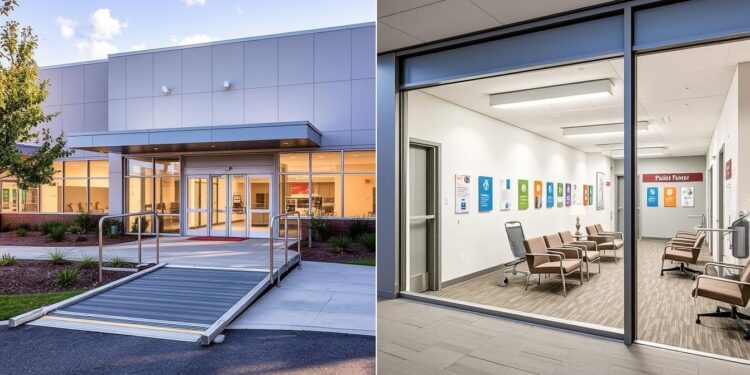
Modern healthcare needs new ways to make facilities both accessible and efficient. About 25% of U.S. adults have disabilities, making it key to design for all. Creating spaces that meet various patient needs is essential.
Healthcare buildings must be designed to include everyone, regardless of age or mobility. Studies show people with disabilities face big challenges in getting healthcare. This calls for a complete overhaul of healthcare spaces.
Designing healthcare facilities is complex. It must blend technology, comfort, and efficiency. Good design can help patients heal faster, improve staff work, and raise the quality of care.
Table of Contents [hide]
- 1 Understanding Modern Healthcare Infrastructure Requirements
- 2 Building Accessible and Efficient Healthcare Facilities
- 3 Designing Patient-Centric Healthcare Environments
- 4 Healthcare Facility Space Planning and Flexibility
- 5 Medical Equipment Management and Integration
- 6 Sustainable Healthcare Design Practices
- 7 Technology Infrastructure for Modern Healthcare
- 8 Healthcare Facility Safety and Infection Control
- 9 Energy Efficiency in Healthcare Buildings
- 10 Staff Facilities and Operational Efficiency
- 11 Accessibility Standards and Compliance
- 12 Emergency Preparedness and Facility Resilience
- 13 Quality Assessment and Performance Metrics
- 14 Conclusion
Key Takeaways
- 25% of U.S. adults have disabilities requiring specialized healthcare infrastructure
- Patient-centered design improves health outcomes and experiences
- Accessibility is critical for inclusive healthcare environments
- Technological integration supports enhanced patient care
- Efficient facility design reduces operational challenges
Understanding Modern Healthcare Infrastructure Requirements
Modern healthcare infrastructure is a mix of design, technology, and care for patients. Hospital design and planning have changed a lot. Now, they focus on making places that help patients get better and work well.
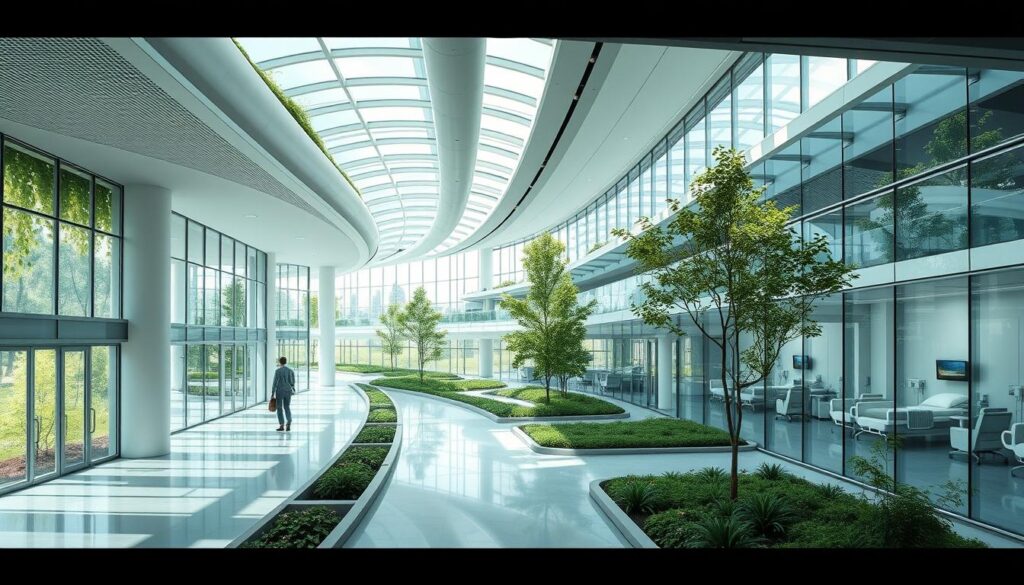
- Integrated technological systems
- Flexible spatial configurations
- Patient-centric design principles
- Advanced medical equipment integration
Essential Design Considerations
Healthcare places now focus on many important things. They aim for better patient care, safety, and being green. The design must cover seven main areas:
- Patient-centered environments
- Operational effectiveness
- Clinical efficiency
- Timely service delivery
- Enhanced safety protocols
- Equitable access
- Sustainable practices
Modern healthcare infrastructure is not just about buildings, but creating healing ecosystems that support complete patient care.
Technological Integration
Modern planning for healthcare facilities includes the latest tech. Digital health solutions are changing old ways. They make it possible for:
- Real-time patient information access
- Improved communication systems
- Advanced diagnostic capabilities
Spatial Efficiency Metrics
| Infrastructure Component | Design Requirement | Performance Impact |
|---|---|---|
| Patient Rooms | Single-room configurations | 50% reduction in infection transmission |
| Technology Infrastructure | Integrated digital systems | 30% improvement in operational efficiency |
| Spatial Layout | Flexible design principles | 40% enhanced adaptability |
The future of hospital design is about smart, flexible infrastructure. It will mix new tech with care for patients.
Building Accessible and Efficient Healthcare Facilities
Inclusive healthcare needs new designs that focus on the patient. Today’s healthcare must mix accessibility with efficiency. With 22.2% of U.S. adults having disabilities, making medical spaces welcoming is key for good care.

- Universal spatial layouts
- Intuitive navigation systems
- Adaptable infrastructure
- Barrier-free architectural approaches
“Design is not just about appearance, but about how spaces function and support human needs.”
Healthcare places must meet different mobility needs. About 13% of adults face mobility issues, making thoughtful design a must.
| Design Consideration | Implementation Strategy | Patient Impact |
|---|---|---|
| Entrance Accessibility | Automatic doors, ramp integration | Improved independent movement |
| Examination Room Layout | Wider doorways, adjustable examination tables | Enhanced patient comfort |
| Wayfinding Systems | Clear signage, color-coded navigation | Reduced patient anxiety |
Patient-centric design goes beyond physical changes. It also includes digital access, communication help, and inclusive tech. These steps make healthcare spaces truly welcoming.
Designing Patient-Centric Healthcare Environments
Healthcare design has changed a lot. Now, it focuses on making spaces that are comfortable, dignified, and healing. These spaces support both physical and emotional health.

Today, we know that the environment is key to patient recovery and experience. Good medical facilities use design to cover all aspects of patient care.
Good healthcare places need easy-to-use navigation systems. This helps reduce stress and confusion for patients. Some key strategies include:
- Color-coded directional signage
- Clear, large-print wayfinding maps
- Digital interactive information kiosks
- Strategically placed landmark indicators
Privacy and Dignity Considerations
Designing for patients means keeping their dignity in mind. This is done through careful planning of space. This includes:
- Soundproof consultation rooms
- Flexible privacy curtains
- Respectful patient screening areas
- Gender-neutral accommodation options
Therapeutic Environment Design
Healing spaces are more than just functional. Innovative design elements like natural light, calming colors, and views of nature help reduce anxiety. They also help patients recover faster.
“Design is not just about aesthetics, it’s about human experience and healing.” – Healthcare Design Expert
Using patient-centric design makes healthcare places truly special. They are not just useful, but also help patients feel better and recover faster.
Healthcare Facility Space Planning and Flexibility
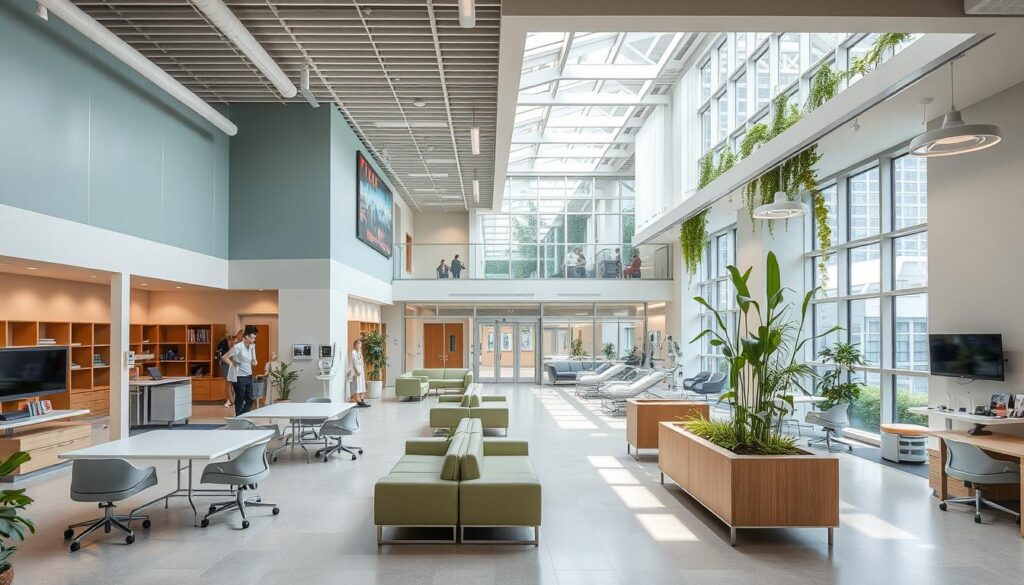
Planning medical facilities needs smart strategies for flexible healthcare spaces. Modern hospitals must use space wisely, adapting to new healthcare needs and tech.
Good space planning in healthcare means thinking about a few key things:
- Modular design concepts
- Multi-functional space utilization
- Future-proofing architectural strategies
- Flexible service configurations
Radiology departments show the challenge of space use. They take up 22% of space but only make 12% of revenue. This highlights the need for smart space use.
“Flexibility in healthcare design is not just about physical space, but about creating environments that can adapt to changing medical technologies and patient care approaches.”
Improving medical facility planning includes:
- Using computerized maintenance management systems
- Creating standardized multipurpose spaces
- Developing scenario-based operational plans
| Space Planning Element | Design Consideration | Operational Impact |
|---|---|---|
| Equipment Mobility | Caster-mounted equipment | Enhanced adaptability |
| Wayfinding | Clear signage and navigation | Improved patient experience |
| Space Transformation | Multipurpose room designs | Increased operational efficiency |
Healthcare facility managers must find a balance. They need to make spaces that are both cost-effective and flexible. These spaces should quickly adapt to new medical tech and patient care needs.
Medical Equipment Management and Integration
Smart hospital technology has changed healthcare a lot. It’s now easier to manage and use medical equipment. This change makes sure patients are safe and care is efficient.
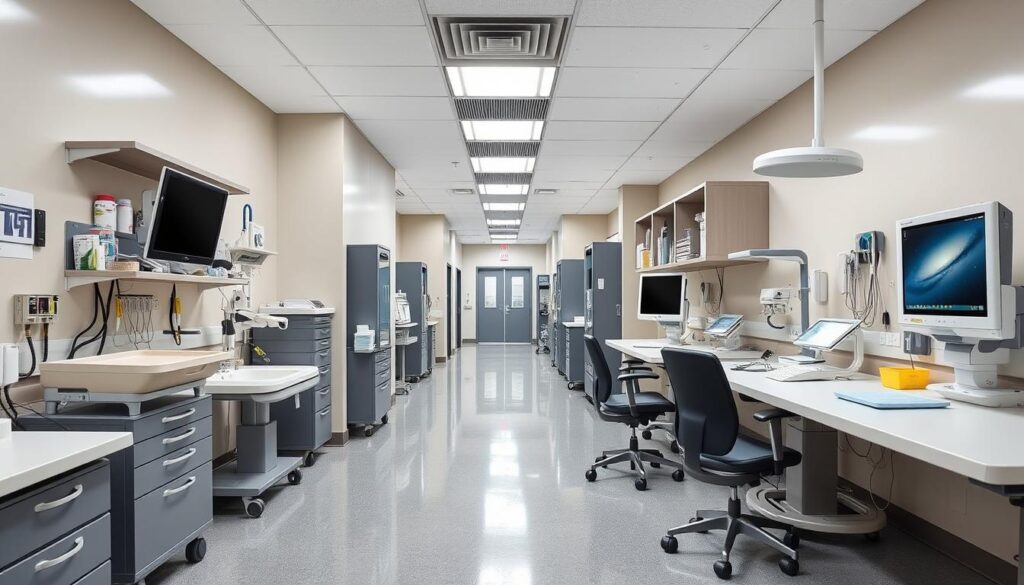
Today’s hospitals have big challenges in managing their equipment. They need to use new tech in a smart way. This means looking at many important parts.
Equipment Lifecycle Management
Managing equipment well means a few key steps:
- Planning how to buy equipment
- Keeping up with maintenance
- Tracking how well devices work
- Knowing when to replace them
Technology Integration Strategies
Integrating medical devices needs a few important things:
| Integration Component | Key Considerations |
|---|---|
| Data Standardization | Using HL7 and FHIR protocols |
| Interoperability | Making sure devices work together |
| Security Measures | Using encryption and access controls |
Quality Assurance Protocols
Healthcare needs strict quality control. Important quality checks include:
- Regularly checking devices
- Watching how well they work
- Following rules and standards
- Managing risks
Integrating medical devices can cut down on paperwork by up to 75%. It can also lower medical mistakes by 30%.
The future of smart hospitals is about smart, connected systems. These systems track things in real time, lower risks, and make care better for patients.
Sustainable Healthcare Design Practices
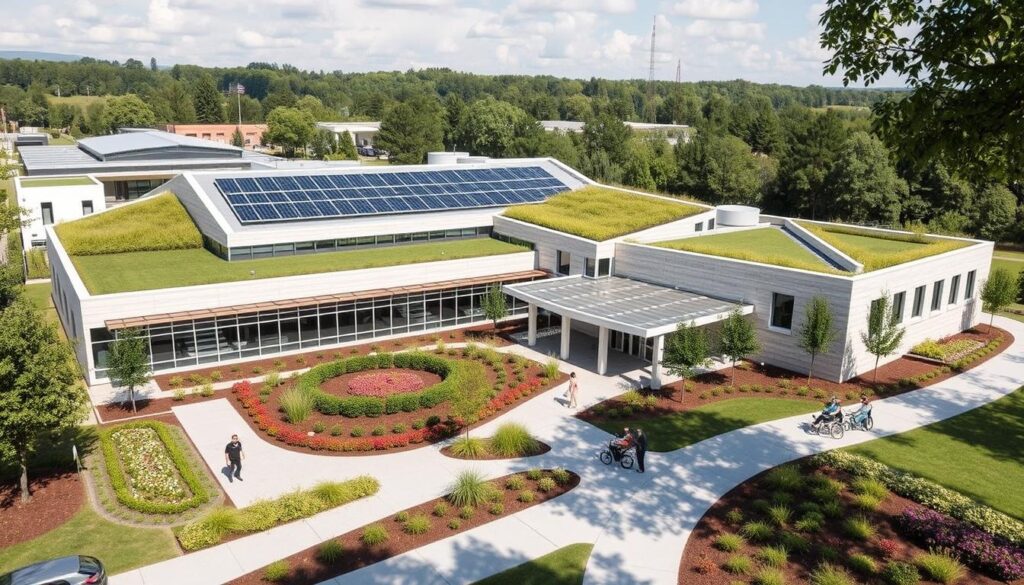
Sustainability in healthcare is a big change in making healthcare places better and more efficient. The building and design world uses over 30% of the Earth’s natural resources. So, making things sustainable is key for saving our planet.
Healthcare places use almost twice as much energy as a typical office building. Architects and designers are finding new ways to lessen harm to the environment.
“Sustainable design is not just an option—it’s a necessity for modern healthcare infrastructure.”
Key Sustainability Strategies
- Renewable energy integration
- Energy-efficient system implementation
- Rainwater harvesting techniques
- Passive solar design principles
Sustainable healthcare design is more than just saving energy. It’s about making places that help patients feel better and save money too.
| Sustainability Metric | Impact |
|---|---|
| Carbon Emissions from Built Environment | 40% of annual global emissions |
| Annual Healthcare Construction | 100 million square feet |
| Energy Consumption Reduction Potentia | Up to 30-50% through green design |
Studies show that sustainable design can really help patients. Being near natural light and views can lower pain and shorten stays. This way, healthcare places become places of healing, not just treatment.
Technology Infrastructure for Modern Healthcare
The world of healthcare is changing fast with new digital technologies. Smart hospital tech is making patient care better, making things run smoother, and improving how we get medical help.
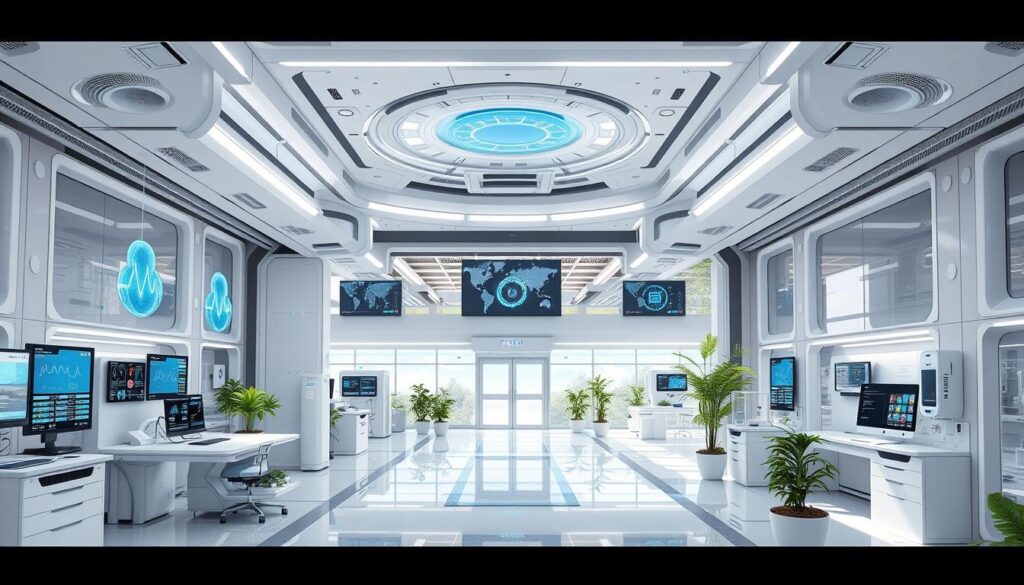
Healthcare places are now using new tech to make things better for patients and to make things run more smoothly. This new tech creates a big system that helps us give better medical care.
Digital Health Integration
Digital health integration is a big step forward in healthcare. Some key tech advancements include:
- Electronic Health Records (EHRs)
- Telemedicine platforms
- Remote patient monitoring systems
- Artificial Intelligence diagnostics
Information Management Systems
Today’s healthcare needs smart systems to handle information well. These systems help with:
- Keeping patient info in one place
- Updating medical records quickly
- Sharing data safely between doctors
“The future of healthcare is digital, connected, and patient-centric.” – Healthcare Technology Experts
Smart Building Technologies
Smart hospital tech isn’t just about digital stuff. It also includes smart building management. This tech makes healthcare places better by:
- Using less energy
- Keeping the climate just right
- Improving security
- Making patients more comfortable
Building a strong healthcare system needs careful planning, money, and keeping up with new tech.
Healthcare Facility Safety and Infection Control
Building safe and efficient healthcare facilities is key. Modern hospitals focus on stopping disease spread and keeping patients healthy. This goes beyond just looks.
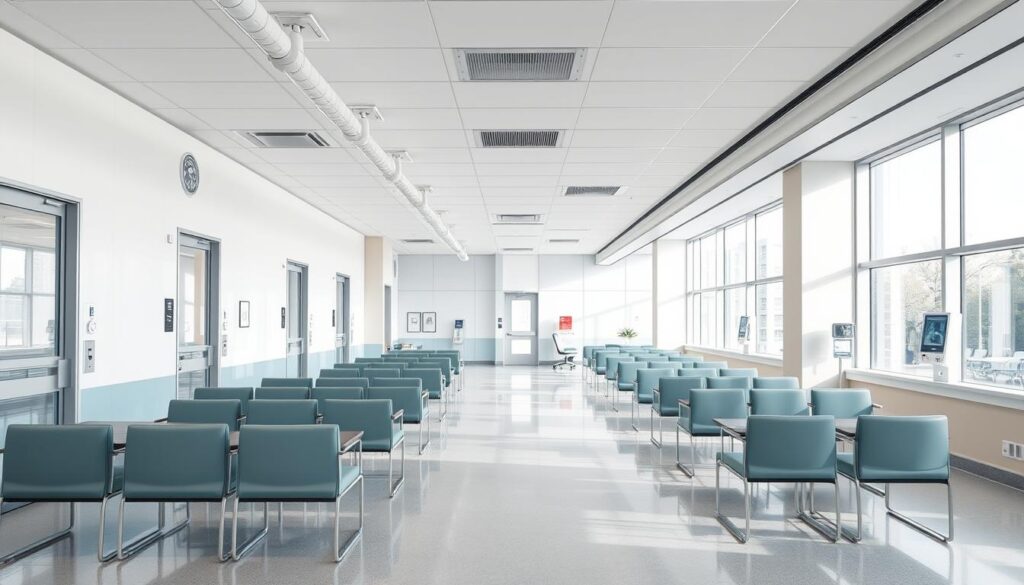
The SARS outbreak taught us a lot about stopping infections. Important design points for safe hospitals include:
- Advanced ventilation systems
- Strategic room layout
- Antimicrobial surface materials
- Isolation room configurations
Studies show better infection control with smart hospital design. Bronson Methodist Hospital in Michigan saw a 10-11% drop in infections with new designs and airflow.
Effective hospital design is not just about architecture, but about creating healing environments that actively prevent disease transmission.
Key design elements for infection control are air pressure, self-closing doors, and negative pressure rooms. These need careful planning.
The $40 billion yearly spend on healthcare buildings shows its importance. Smart design choices can greatly lower infection risks. This makes hospitals safer for everyone.
Energy Efficiency in Healthcare Buildings
Sustainability in healthcare is now a top priority. Healthcare buildings use a lot of energy, which affects the environment. By using energy wisely, we can cut costs and reduce harm to the planet.
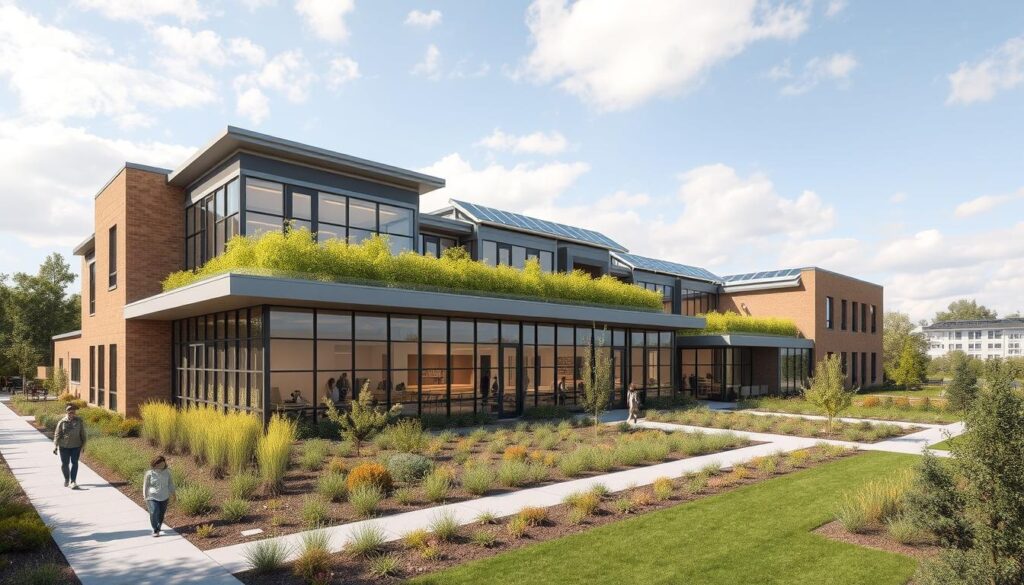
Healthcare buildings use a lot of energy. In the U.S., healthcare costs over $8 billion on energy each year. This also leads to 8.5% of national greenhouse gas emissions. So, making healthcare buildings more energy-efficient is key.
HVAC Optimization Strategies
Heating, ventilation, and air conditioning (HVAC) systems use a lot of energy. Making them work better can save a lot:
- Implement demand-controlled ventilation
- Use motion sensors for precise energy management
- Upgrade to high-efficiency HVAC equipment
- Regular maintenance of existing systems
Lighting Energy Management
Good lighting can also save a lot of energy. LED lights are a big help:
- Estimated return on investment within eight years
- Reduced electricity usage
- Lower maintenance requirements
- Improved light quality for healthcare environments
Resource Conservation Methods
“Sustainable design is not just an option, but a necessity in modern healthcare infrastructure.” – Green Healthcare Design Expert
Conserving resources means using many strategies:
- Implement energy monitoring systems
- Invest in thermal insulation
- Explore renewable energy sources
- Conduct regular energy audits
By using these methods, healthcare buildings can help the environment. They can also save over $55,000 a year by being more energy-efficient.
Staff Facilities and Operational Efficiency
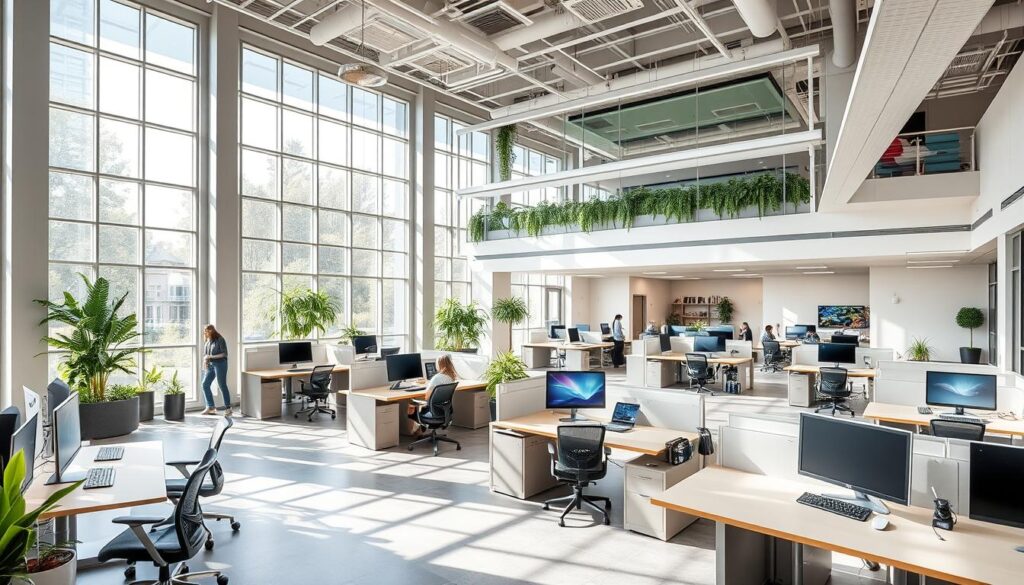
Planning medical facilities needs a smart approach to make great work spaces for healthcare workers. Today’s healthcare places know that happy staff means better care for patients and better work for the team.
Designing good staff areas means thinking about a few key things:
- Creating spaces where teams can work together well
- Using designs that are easy on the body
- Building break rooms that can do many things
- Adding the latest tech to the space
Being efficient in healthcare isn’t just about the space. New tech like IoT sensors and AI is changing how places run every day. It helps predict when things might break, cuts down on downtime, and makes sure resources are used right.
“Effective staff facilities are not just about physical comfort, but about creating environments that support professional excellence and patient care.” – Healthcare Design Institute
Planning for medical facilities must also think about new roles like physician assistants and healthcare scientists. They need work spaces that are flexible and use technology well, to help care teams work together.
Some key ways to improve efficiency include:
- Using a single system to manage the place
- Making communication clear and easy
- Using data to make smart choices
- Keeping staff up to date with training
To make healthcare places better, we need to think about tech, design that puts people first, and flexibility in how things work.
Accessibility Standards and Compliance
Healthcare accessibility standards are key to making healthcare spaces welcoming for everyone. The Americans with Disabilities Act (ADA) sets clear guidelines for equal access to medical facilities.
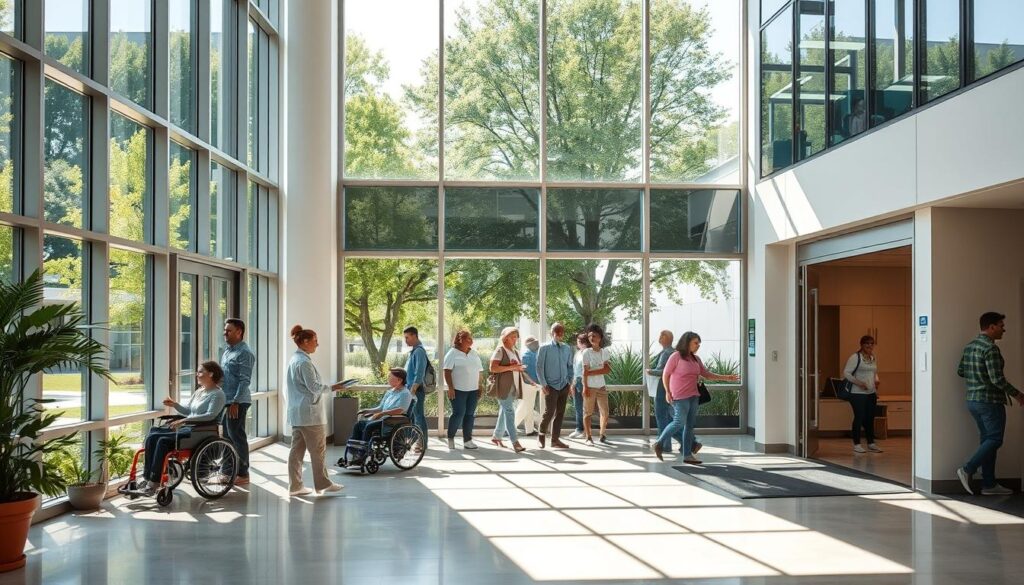
The journey to accessible healthcare has seen major milestones. Important dates show how inclusive healthcare design has evolved:
- July 26, 1991: Original ADA Accessibility Guidelines published
- September 15, 2010: DOJ adopts new ADA Standards
- March 15, 2012: New standards become effective for construction
ADA Requirements Implementation
Healthcare facilities must follow strict accessibility rules now. The rules require that any construction after March 15, 2012, must be fully accessible for people with disabilities.
Universal Design Principles
Universal design is more than just following rules. It makes environments usable by everyone, no matter their physical abilities. This approach makes healthcare spaces welcoming and functional for all patients.
Mobility Considerations
| Accessibility Feature | Implementation Requirement |
|---|---|
| Wheelchair Access | Clear pathways minimum 36 inches wide |
| Signage | High contrast, tactile characters |
| Examination Rooms | Adaptable equipment and maneuvering space |
“Accessibility is not a feature, it’s a fundamental right in healthcare design.” – Accessibility Design Expert
The future of inclusive healthcare requires ongoing changes. With new rules coming for digital and physical access, healthcare providers must keep up. This ensures care that truly focuses on the patient.
Emergency Preparedness and Facility Resilience
Healthcare needs strong emergency plans. Modern hospitals must be ready for big emergencies, like natural disasters or pandemics.
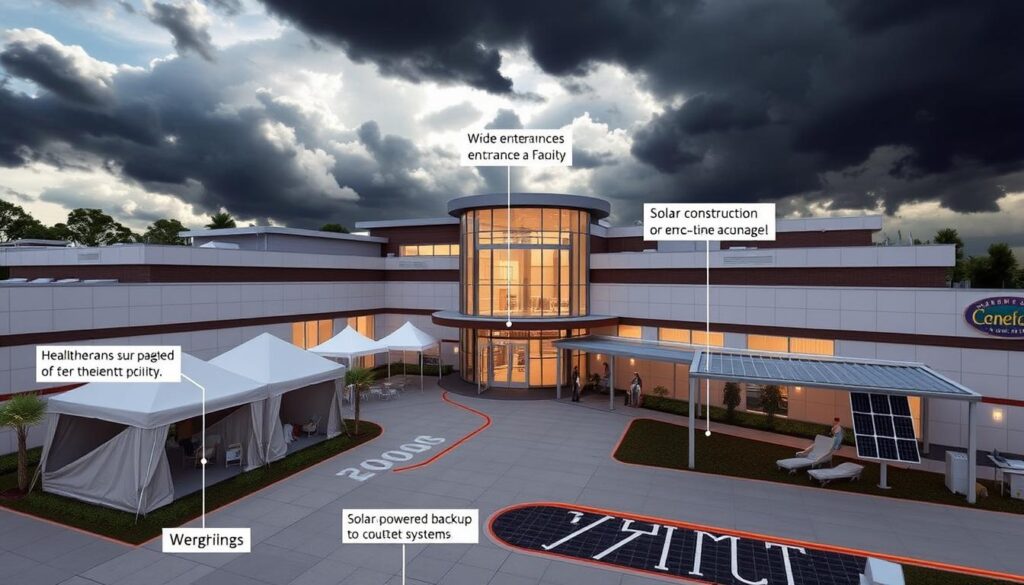
Hospitals are key in disaster response. They must have several important parts to be resilient:
- Emergency critical care capabilities
- On-site rescue readiness
- Emergency medical treatment protocols
- Surge capacity management
- Mass casualty triage systems
“Safe and resilient hospitals are not just buildings, but lifelines during community crises.” – World Health Organization
The Sendai Framework aims to cut infrastructure damage by 2030. Healthcare places must have strong plans for resilience. These plans tackle building, operation, and tech challenges.
Important resilience signs include:
| Resilience Dimension | Key Considerations |
|---|---|
| Structural Resilience | Building integrity, hazard resistance |
| Operational Flexibility | Adaptable medical spaces, emergency protocols |
| Resource Management | Backup power, medical supply reserves |
Good hospital design blends emergency readiness into daily work. This way, healthcare can quickly face unexpected issues while keeping patient care going.
Quality Assessment and Performance Metrics
Healthcare standards are key to checking if medical places work well. By looking at how buildings are made, we can see if they help patients get better care.
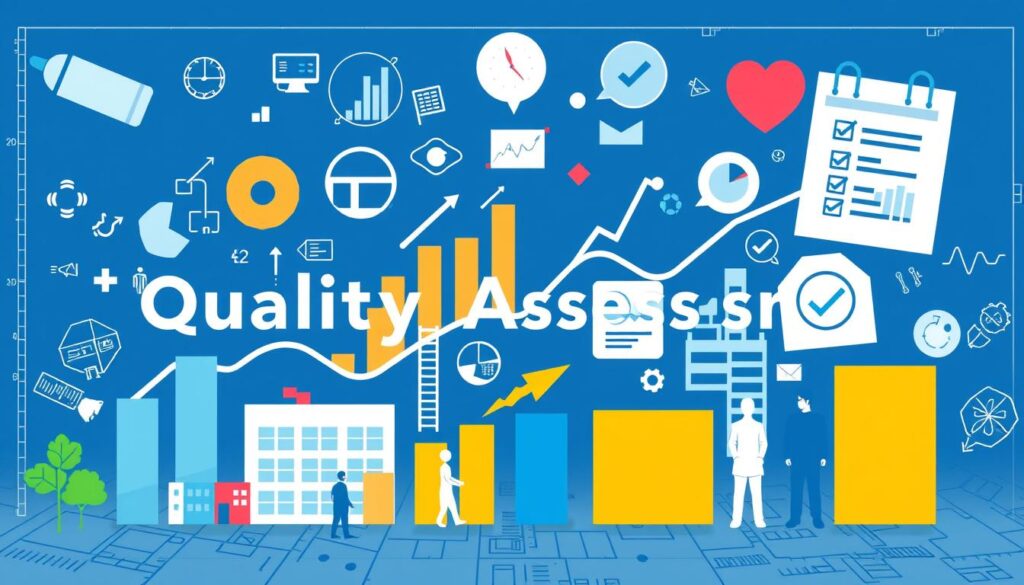
Measuring healthcare quality has gotten better, with many countries tracking how well care is given. Groups like the OECD and EU Commission are helping by comparing healthcare quality worldwide.
“Quality is not an act, but a habit of continuous improvement in healthcare design and delivery.”
Key Performance Metrics
- Patient mortality rates
- Readmission percentages
- Patient satisfaction scores
- Operational efficiency indicators
- Treatment outcome measurements
| Metric Category | Assessment Focus | Measurement Approach |
|---|---|---|
| Patient Experience | HCAHPS Survey Results | Comprehensive patient satisfaction evaluation |
| Clinical Effectiveness | Mortality and Readmission Rates | Statistical analysis of patient outcomes |
| Operational Efficiency | Hospital Bed Occupancy | Financial and resource utilization metrics |
Today, healthcare places use new tech to gather and study data. This helps make design choices that better care and work better.
The rise of value-based healthcare has made measuring outcomes more important. Governments see good quality checks as key to finding top healthcare providers and boosting the system’s performance.
Conclusion
Building healthcare facilities that are both accessible and efficient is key. This article shows how important it is to mix technology, patient needs, and design. Healthcare needs to focus on solutions that work for everyone, no matter their needs or where they live.
In cities like Ho Chi Minh City, the need for better healthcare is clear. With 9 million people and not enough hospitals, the right design is critical. Using universal design helps make spaces that everyone can use, regardless of age or ability.
As we move forward, healthcare buildings should use the latest technology and be good for the planet. They should also put patients first. This way, we can make places where doctors and patients can heal together.
Improving healthcare facilities is a never-ending effort. It’s about always getting better and meeting new health needs. Everyone involved must keep pushing for better designs and solutions. This way, quality healthcare can be available to everyone.






